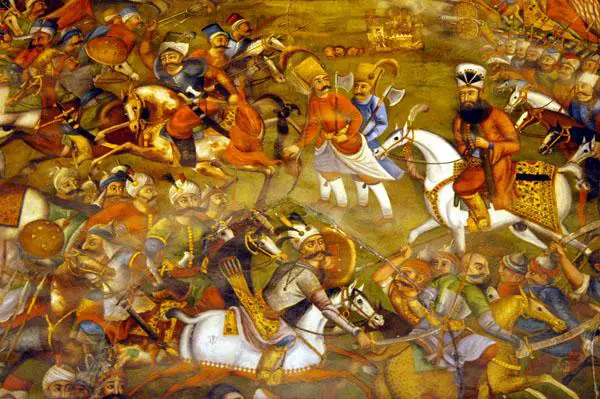The Battle of Chaldiran, fought on August 23, 1514, was a pivotal confrontation between the Ottoman Empire and Safavid Iran, marking one of the most significant episodes in the Turko-Persian Wars. This battle, occurring near the town of Chaldiran in what is now Iran (latitude: 39.0649837, longitude: 44.3844679), exemplifies the stark military and ideological divide that shaped early 16th-century Middle Eastern geopolitics.
Spanning across the rugged terrain of Anatolia, the battle not only redefined the power dynamics in the region but also symbolized the ideological conflict between the Sunni Ottomans and the Shi’a Safavids. It is immortalized as a clash that cemented Ottoman dominance over eastern Anatolia and the western territories of the Safavid Empire.
Historical Context
The rise of the Safavid Empire under Shah Ismail I (r. 1501–1524) posed a direct challenge to the Ottoman Sultan Selim I (r. 1512–1520). Shah Ismail’s establishment of a Shi’a theocracy and his active propagation of Shi’a Islam threatened Ottoman influence, especially in eastern Anatolia, which had a significant population of Qizilbash tribes loyal to the Safavid cause.
Sultan Selim, intent on consolidating Ottoman power and neutralizing the Safavid threat, launched a military campaign against Shah Ismail. The Turko-Persian War in Anatolia, which culminated in the Battle of Chaldiran, was a direct result of these escalating tensions.
Prelude to the Battle
The lead-up to Chaldiran was marked by aggressive maneuvers on both sides. Selim’s forces, bolstered by disciplined Janissaries and advanced artillery, marched through Anatolia to engage the Safavid army. The Ottomans were well-equipped and logistically supported, with a formidable arsenal that included heavy cannons and muskets, which were revolutionary for the time.
In contrast, Shah Ismail’s forces, though highly motivated and numerically comparable, relied predominantly on traditional cavalry and melee combat. The Safavid army was deeply entrenched in medieval military strategies and lacked the technological advancements that defined the Ottoman forces.
The Battle
The battle took place on a plain near Chaldiran. The Ottomans, leveraging their superior artillery and firearms, executed a tactical formation designed to neutralize the cavalry-centric strategies of the Safavids. The Ottoman deployment featured disciplined infantry units protected by wagons, a formation known as the tabor. Behind these wagons, cannons and muskets created a lethal field of fire.
The Safavids, led by Shah Ismail himself, launched aggressive cavalry charges aimed at breaking Ottoman lines. However, the devastating effect of Ottoman artillery and gunfire shattered these assaults. The Safavid forces suffered heavy casualties, and their formations disintegrated under the relentless barrage.
Outcome and Significance
The Ottoman Empire emerged victorious, while the Safavid forces suffered a catastrophic defeat. Shah Ismail barely escaped capture, retreating to Tabriz, the Safavid capital. This victory not only secured Ottoman control over eastern Anatolia but also allowed Sultan Selim to annex key territories, including parts of Syria and Iraq.
The battle also demonstrated the superiority of gunpowder technology over traditional cavalry tactics, heralding a new era in warfare. The Safavid Empire, recognizing its vulnerability, began to modernize its military apparatus in subsequent years.
Broader Implications
The ideological divide between the Sunni Ottomans and Shi’a Safavids deepened in the aftermath of Chaldiran. The battle cemented the Ottoman position as the dominant Islamic empire in the region, while the Safavids struggled to recover from the humiliation.
Additionally, the victory at Chaldiran allowed the Ottomans to extend their influence into the Levant and Mesopotamia, regions crucial for their aspirations of empire-building. The conflict further entrenched the sectarian divide that would shape Middle Eastern geopolitics for centuries.
Military Analysis
According to the Lehmann-Zhukov scale, the battle ranks at a 3.0, indicating its significant impact on the regional balance of power. The Ottoman utilization of gunpowder artillery and strategic formations highlighted their military ingenuity. Conversely, the Safavid reliance on traditional methods underscored the urgent need for modernization, which they later undertook.
A comparison of both forces reveals the decisive factors in the Ottoman victory:
| Aspect | Ottoman Empire | Safavid Empire |
|---|---|---|
| Leadership | Sultan Selim I | Shah Ismail I |
| Key Strengths | Advanced artillery, disciplined infantry | Fierce cavalry, high morale |
| Technological Edge | Cannons, muskets, strategic formations | Traditional melee combat |
| Outcome | Decisive victory | Defeat, loss of territories |
Cultural and Political Legacy
The Battle of Chaldiran had lasting repercussions beyond the battlefield. It established the eastern boundaries of the Ottoman Empire and laid the groundwork for the Safavid reformation. Politically, it symbolized the beginning of Ottoman-Safavid rivalry, which would continue for over a century.
Moreover, the battle underscored the importance of technological innovation in military dominance. It forced the Safavid Empire to reconsider its strategies, leading to a gradual but essential transformation in its military structure.
Conclusion
The Battle of Chaldiran stands as a turning point in Middle Eastern history. It exemplified the clash of empires and ideologies that defined the 16th century. The Ottoman victory not only reaffirmed their position as a preeminent power but also highlighted the transformative impact of technology in warfare. As one of the most consequential battles of the Turko-Persian Wars, Chaldiran remains a subject of enduring historical interest and analysis.
